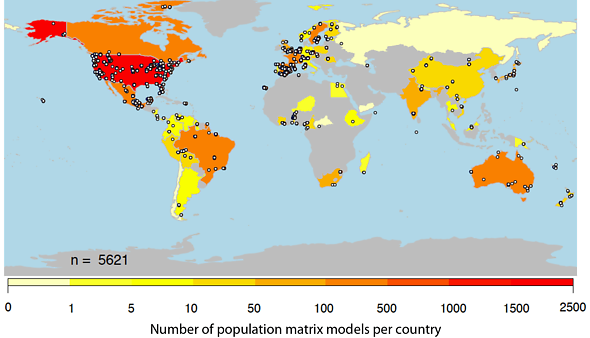November 10, 2014 | News | New database
COMPADRE: Worldwide achievement for plant demography
A new database with demographics of a unique worldwide coverage of plant species called „COMPADRE Plant Matrix Database“ went online today at www.compadre-db.org.
The open access repository, which was substantially supported by and built at the Max Planck Institute for Demographic Research (MPIDR) in Rostock, allows scientists to answer a whole range of outstanding ecological and evolutionary questions. ”One of the most important applications will probably be projections on how plant populations react to climate change and other environmental threats,“ says Alexander Scheuerlein, biodemographer and COMPADRE representative at the MPIDR.
The new database holds demographic data on reproduction (fertility or clonal reproduction), survival and growth for currently 600 species in almost ten times as many matrices which form so called „matrix population models“ (MPM). Each model describes a plant species under different conditions such as environmental influences or geographic location.
600 plant species from around the globe in one database
Building upon the groundbreaking MPM framework developed by Hal Caswell (Woods Hole Oceanographic Institution, Massachusetts, USA and University of Amsterdam, Netherlands), demographic values in matrix population models are not ordered by age as in human demography, but by stages in the plant’s lifecycle. While in human demography indicators vary markedly with age, the most important changes for plants occur at the transition from one lifecycle stage to the next. For instance, demographic data is different when a plant is still at the seed bank stage, vegetatively dormant or already actively doing photosynthesis.

Good coverage worldwide: Geographic locations of the current 5,621 matrix population models within COMPADRE (as of November 10, 2014). Dots represent approximate locations of each study population (when available). © MPIDR, Roberto Salguero-Gómez et al.
”The main achievement of COMPADRE is to collect and digitize plant data from several hundred studies spread over the whole globe and organize them in one single online repository,“ says Alexander Scheuerlein. Scientists worldwide helped in gathering and processing the data for many years, coordinated by lead researcher Roberto Salguero-Gómez at the MPIDR and The ARC Centre of Excellence for Environmental Decisions (CEED), Australia.
Together with the online portal the researchers now published the introductory scientific paper The COMPADRE Plant Matrix Database: an Open Online Repository for Plant Demography in the Journal of Ecology.
State of the art research with matrix population models
The fundamental pieces of information in COMPADRE are the matrix population models (MPM). Each MPM describes the dynamics of a population as a combination of three processes: survival (including stasis and retrogression), sexual reproduction, and clonal or vegetative reproduction. However, MPMs alone are of little value. In order to allow users to interpret the models, COMPADRE contains additional information that is study- or matrix-specific, like experimental treatment, ecoregion, growth form, taxonomy, and phylogeny.
Although COMPADRE already is far more powerful than any other database on plant demographics, the current release is just a starting point. More species and matrices will be added in future versions at the same website.
For MPIDR demographer Alexander Scheuerlein the new database opens exciting research opportunities, especially in fundamental science. “The data is crucial to our understanding of the ecological conditions that have shaped plant evolution,“ says Scheuerlein. In particular, research with COMPADRE data may unveil more on ”negative senescence“ in plants, one of the most puzzling phenomena in biodemographic science right now: Species whose probability to die decreases the older they get.
Further Information
Researchers interested in contributing data or obtaining help or more information on COMPADRE please contact compadre-contact@demogr.mpg.de.
Introductory paper:
The COMPADRE Plant Matrix Database: an Open Online Repository for Plant Demography, Journal of Ecology (DOI: 10.1111/1365-2745.12334)
Contact